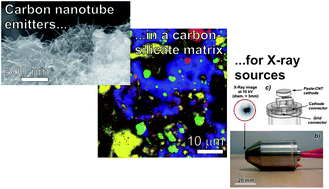High-temperature processable carbon–silicate nanocomposite cold electron cathodes for miniature X-ray sources
Abstract
We report on the fabrication, Raman characterization and electron emission behavior of cold electron cathodes that are specifically designed to be used in miniature X-ray sources. The cathodes are fabricated by screen-printing a nanocomposite paste comprising multiwall


 Please wait while we load your content...
Please wait while we load your content...